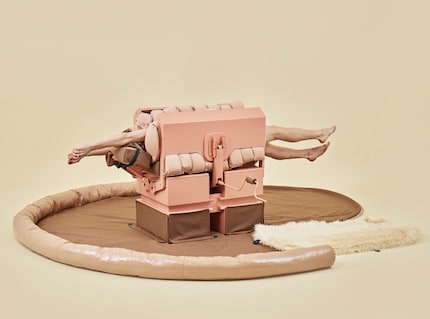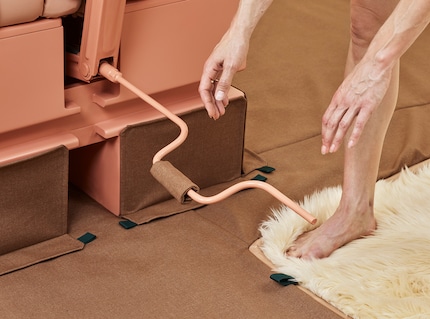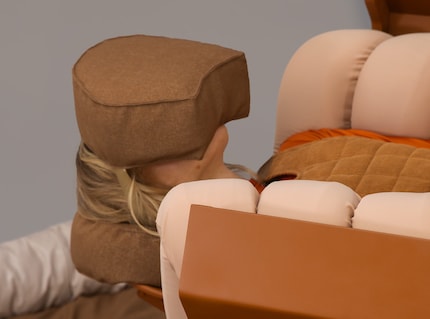
«Technology has led to a touch crisis»
The more we communicate via digital devices, the greater the risk that touching will become less and less common. To replace human touch, Sci-fi artist Lucy McRae has designed a machine that hugs you.
Sci-fi artist Lucy McRae is already tackling tomorrow's problems today. She thinks up potential scenarios to prepare us for the future and then develops «future survival kits». To this end, she works with scientists and synthetic biologists who specialise in producing useful products made from biological materials for the benefit of society. This is how the hugging machine called «Compression Carpet» was developed. When you are given a hug, it triggers the release of oxytocin in the brain – the hormone responsible for promoting feelings of happiness. If there's a lack of human touch, it can have a negative impact on our well-being. The artist explained to me what motivates her to create things that aim to protect us from possible social isolation.
How did you come up with the idea of a machine that mimics a hug?
Lucy McRae: Touch is the first sense developed in the womb, and yet, it remains a sort of phenomenon. Our submissive behaviour towards technology has led to a touch crisis. Hugs are endangered. In 2015, curiosity led me to create an artwork, called the «Future Day Spa» that gives 360-degree hugs via a machine. In the ’60s, NASA used vacuum pressure as a way to prepare astronauts for the lack of gravity in space; by placing the body in a vacuum, the blood circulation increases. It was during the Future Day Spa when a participant who suffered from the fear of touch and had no physical contact with others, hugged me after a nine-minute treatment! This unexpected encounter motivated me to create the «Compression Carpet».


Was your work inspired by the «Hug Machine» by Temple Grandin?
Temple Grandin has been a long-time inspiration. Prior to the Future Survival Kit which offers a manual hug, my artworks had been automatic, diallable machines. Challenged with gallery constraints, we wanted to make an analogue version that works around the body manually – no plugs, just another human.
If a hug is missing, a human counterpart is missing. Why did you create the Compression Carpet in a way that it takes two people to use it?
The problem with living through a revolution is that it’s impossible to take the long view of what’s happening – hindsight gives us the point of view. Would a machine that hugs you be a solution or critique of where we are at? We are living through the most profound transformation – as if we are puppets of technology. By letting somebody other than yourself decide on the tightness of the machine’s grip, you give over control. In a way is this where we are at – are we in control of our future?**
Are there other interactions that could be just as important to prevent a lack of intimacy?
Oxytocin is released in the brain during sex, breastfeeding and hugs. For Paola Anotnelli’s Broken Nature exhibition in Milan, we exhibited the Compression Cradle, a machine that uses air to swaddle the body. I met a doctor at this show and learned that if pain or negative sensations are experienced while being touched, the body won’t release those «feel good» hormones. The types of innovations we create where the body is covered entirely, can’t be recreated by human touch, unless, you placed multiple people, all weighing the same, in a way that every edge of your body was covered. We speculate surface area is significant and critical to future intimacy. Next year I’ve been commissioned to make an architectural scale machine, let's see what we learn in Venice.
What’s next for the Future Survival Kit?
In the studio we operate with a startup mentality: We prototype upfront, break things early and learn from failure. This kind of attitude fuels and nurtures change and is the antithesis to perfectionism. It means that we operate from a place of the unknown and this requires everyone involved (including our clients) to value that through the risk we innovate. As a kid, I arranged dried flowers into sustainable bundles. It’s a childhood dream to have a line of products and transform things from one to another. If art can be crystallised into long-lasting commercial products that change behaviour and prepare us for the future, I would love that as a next step.

In my upcoming series «Social Design», I will take a closer look at projects like the Future Survival-Kit in order to show in what ways designers nowadays are keeping our well-being in mind. Follow me as an author to stay updated.
Like a cheerleader, I love celebrating good design and bringing you closer to everything furniture- and interior design- related. I regularly curate simple yet sophisticated interior ideas, report on trends and interview creative minds about their work.
From the latest iPhone to the return of 80s fashion. The editorial team will help you make sense of it all.
Show all